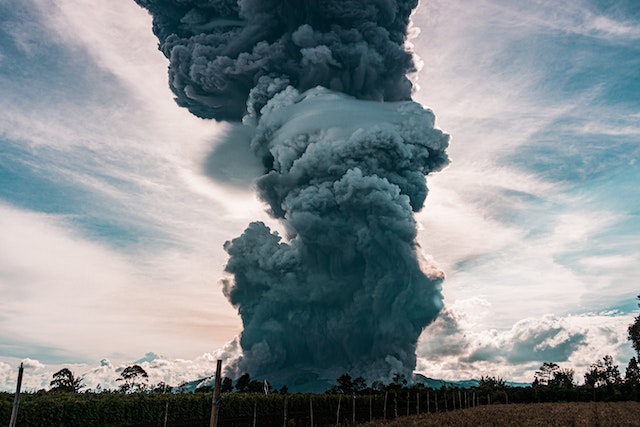
How is volcanic ash made and how dangerous is it? Volcanic ash is made of rock, mineral and glass particles that are smaller than 2 mm. It can be extremely dangerous.
Volcanic ash is formed during a volcanic eruption. Magma inside the volcano contains dissolved gases and water. These gases are mostly sulfur dioxide and carbon dioxide. The magma is less dense than the rock around it, so it starts to rise. The pressure decreases while the magma is rising and the gases and water inside it start to expand and form bubbles. As the gases expand, the density of the magma decreases, and it rises even faster. When the gas and water bubbles have expanded to take up about 80% of the magma, it explodes. The gas shatters the magma into tiny pieces and shoots the pieces into the sky. When these pieces hit the cooler air, they solidify, making volcanic ash.
Depending on the strength and size of the volcano, ash can be shot between 2 and 45 km high. The ash particles are extremely small and light, and they fly upwards very easily. As the ash column gets higher, its density decreases, and once it has the same density as the surrounding air the ash particles stop going up and start going sideways with the winds. Ash from a large volcano can be spread for hundreds of kilometers. If an ash cloud gets high enough, ash can enter the stratosphere. This can have disastrous effects because it is less likely to be rained out of the sky and can reflect sunlight away from Earth, lowering global temperatures. The Mount Pinatubo eruption in 1991 lowered global temperatures by 0.5℃. An event like this is usually known as a nuclear winter, and it is probably one of the reasons that the Chicxulub asteroid killed the dinosaurs. It caused huge eruptions that kicked up enormous amounts of dust, ash, and earth into the atmosphere. The winds carried them around the globe and they blocked out all of the sunlight.
Volcanic ash is harmful in a number of ways. If you are close to the eruption, the first danger is pyroclastic flows. These are clouds of extremely hot ash (up to 700℃) that travel at hundreds of miles an hour and flow down the sides of the volcano destroying everything in their path. Pyroclastic flows are the most dangerous part of any volcanic eruption. They can travel for several kilometers, and they have enough heat and kinetic energy to flatten trees and buildings. They are dense and run down the sides of the volcano under the force of gravity, almost like a fast running river. They are impossible to escape from and anybody caught in one will be incinerated.
The second danger is ash that comes down out of the sky. The ash is dense and heavy. Dry ash is ten times heavier than snow and wet ash is twenty times heavier. Also, ash doesn’t melt away like snow does. The ash can build up and easily collapse buildings. This is most likely what happened to Pompeii. The city was buried under about 9 feet of ash.
If you are further away, the airborne ash can also be dangerous. The particles are full of holes, so they are light and can be carried a long way on the wind. The particles are also very jagged, so they can do damage to your eyes, nose, throat and lungs.
Volcanic ash can ground aircraft as well. The clouds look the same as regular clouds and pilots can fly through them without realizing. The jagged ash particles get sucked into the engine and they can erode the moving parts in the engine and block the fuel nozzles. The melting point of the ash is lower than the internal temperature of the engine, so it melts inside the engine but then cools down and sticks to the inside of the turbine blades.
The ash can also damage machinery, disrupt electricity supplies, kill animals, and, if enough is ejected into the stratosphere, cause whole species to go extinct.
So, volcanic ash is made from magma that was shattered into tiny particles of rock, mineral and glass by the rapidly expanding gas inside it. This ash is then shot high into the sky where it is blown around the world. It can be extremely dangerous, often more dangerous than the lava itself. And this is what I learned today.
Sources
https://www.sciencedirect.com/topics/earth-and-planetary-sciences/volcanic-ash
https://en.wikipedia.org/wiki/Volcanic_ash
https://education.nationalgeographic.org/resource/volcanic-ash
https://edition.cnn.com/travel/article/ash-cloud-aircraft-explainer/index.html
https://en.wikipedia.org/wiki/Pyroclastic_flow
